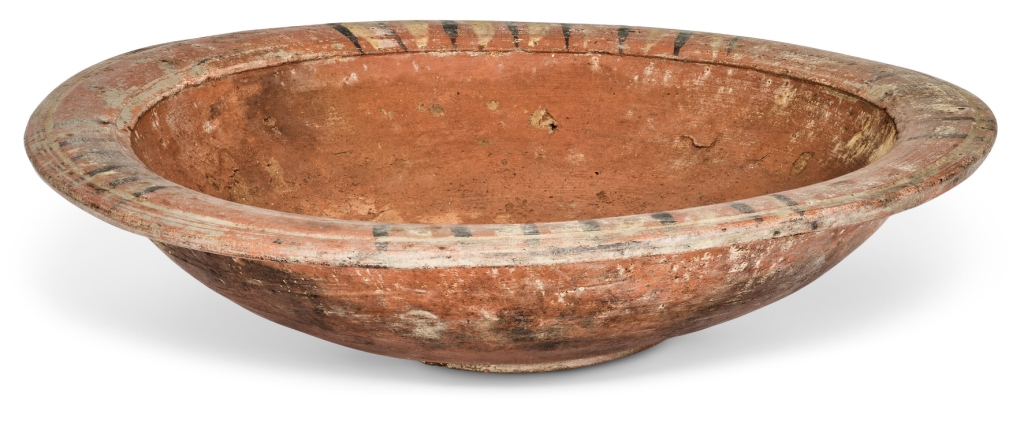After being down for several days due to a cyber attack, the Christie’s website appears to be back up and running. A more detailed description of the items being auctioned from the Schøyen Collection is now available. Among them is the leather cover of Nag Hammadi Codex I along with the separately framed waste papyrus extracted from the cover.
One observation about the catalog entry for this lot: The buyer will also get the bowl that James Robinson often claimed was used to seal the jar in which the Nag Hammadi codices were said to have been found. I want to point out that this bowl has a provenance history that differs from that of the leather cover (and cartonnage) of Codex I. While the quires and leather cover of Codex I took different paths to their current repositories (the quires to Cairo and the cover eventually to the Schøyen Collection), the bowl had a more direct path: an Egyptian family to James Robinson (in 1976) and then to the Schøyen Collection in 1994.
Now, was this in fact “the” bowl used to seal the jar with the codices? For reasons I have outlined in detail elsewhere, I regard the find story or–more accurately–the multiple, conflicting find stories of the Nag Hammadi codices as unreliable. Nevertheless, it’s worth teasing out the tale of the bowl a bit. To the best of my knowledge, Robinson’s fullest account of the bowl is in his book, The Nag Hammadi Story (2014). While summarizing his story of the discovery of the codices, Robinson gave a detailed description of the jar in which the books were said to have been found (a jar that had allegedly been smashed and that Robinson had never seen). He eventually moved on to describe the way this jar had allegedly been sealed and what happened to the bowl used to seal the jar:
“The jar had been closed by laying into its mouth a pottery bowl, which Khalīfah took with him to al-Qaṣr. There he was employed as a servant and camel driver for a Copt, Sami ʿAbd al-Malāk, who took the bowl as a talisman that would bring a blessing. Through the mediation of his wife Umm Nadya, a relative Salib ʿAbd al-Masīḥ, for a modest consideration, made it available for study.”1
In other words, Robinson bought the bowl and took it back to Claremont. What is interesting about the story is that the connection of the bowl to the alleged discovery of the books is the figure of Khalīfah, that is, the brother of Muhammad ʿAli al-Samman, the man most closely associated with the discovery of the codices, whose story (or rather, stories) Robinson spent years investigating. One part of Muhammad ʿAli’s story was a denial that Khalīfah was present at the time of the discovery of the codices.2 Robinson did not believe this part of Muhammad ʿAli’s story.

Another account of Robinson’s purchase of the bowl is provided in James Goehring’s publication of a similar bowl found during excavations of a church at Pbow. Goehring says the following about the bowl Robinson bought:
“Robinson notes that Khalifah took it [the bowl] to the home of the Coptic family of Sami Abd al-Malak and his wife Umm Nadia. When Robinson located the bowl, it was Salib Abd al-Masih, Sami’s nephew, who sold it to him. While Robinson did not know for sure the whereabouts of Sami at that time, one may assume, since Umm Nadia was still present and Salib acted as the one with authority to sell the bowl, that Sami had passed away. Robinson concurred with this assessment.”3
I think it’s important to emphasize that this bowl took a path in the antiquities trade that is different from that of the cover of Nag Hammadi Codex I. We might assume that they had a common origin, but that really is just an assumption. The first time the bowl and the cover of the codex actually have a documented history together is in Claremont, California in 1976 (the cover of Codex I had arrived in Claremont in 1972).4 Treating the cover and the bowl as a unit tends to create the impression of unity and coherence in a “find story” that is actually quite messy when we focus on the details.

- James M. Robinson, The Nag Hammadi Story (Leiden: Brill, 2014), 1.35-36. ↩︎
- Robinson, The Nag Hammadi Story, 1.35. ↩︎
- James E. Goehring, “An Early Roman Bowl from the Monastery of Pachomius at Pbow and the Milieu of the Nag Hammadi Codices,” in L. Painchaud and P.-H. Poirier (eds.), Coptica – Gnostica – Manichaica: Mélanges offerts à Wolf-Peter Funk (Louvain: Peeters, 2006), 57-371, quotation at 361, n. 15. ↩︎
- See the account in Robinson, The Nag Hammadi Story, 1.383-390. ↩︎



According to Christie auction house here
https://www.christies.com/stories/the-crosby-schoyen-codex-d1a2aca873c648a9a5328883f91986ba
“One morning around the beginning of the 4th century, close to where the Nile loops eastward through the southern desert, an Egyptian monk went to begin his day’s work in his monastery’s scriptorium. He was a trained scribe, fluent in Greek as well as in his native Coptic tongue, and today he was to embark on a new task. He had been charged with copying a set of sacred writings into a freshly bound quire of folded papyrus.”
Would it have been bound before the scribe started penning?
For multi-quire codices, the answer was usually copying then binding. Codices with many quires seem to have been typically copied while unbound. With single-quire codices, however, I would hazard that copyists probably copied into codices that were already bound. In some instances, this is demonstrably the case: In a small papyrus codex containing Psalms 72-88 in the Chester Beatty in Dublin, there is a stroke of a letter that runs on to the binding thread, which is a pretty strong indication that this single-quire codex was bound first, then copied.
Pingback: The Sale of the Crosby-Schøyen Codex and its Cost Over Time | Variant Readings